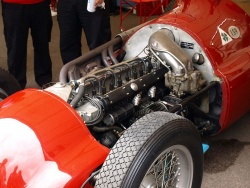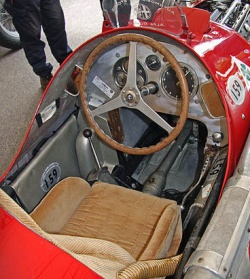Difference between revisions of "Alfa Romeo 158/159 Alfetta"
m |
m |
||
| (15 intermediate revisions by the same user not shown) | |||
| Line 50: | Line 50: | ||
The car's name refers to its 1.5 litre engine and eight cylinders. The voiturette class was for racing cars with 1.5 litre engines, standing in the same relation to the top 'Grand Prix' formula (usually for 3 litre engines) as the [[GP2 series]] does to Formula One today. Alfa's 3 litre racing cars in 1938 and 1939 were the [[Alfa Romeo Tipo 308|Tipo 308]], [[Alfa Romeo Tipo 312/316|312]] and [[Alfa Romeo Tipo 312/316|316]]. | The car's name refers to its 1.5 litre engine and eight cylinders. The voiturette class was for racing cars with 1.5 litre engines, standing in the same relation to the top 'Grand Prix' formula (usually for 3 litre engines) as the [[GP2 series]] does to Formula One today. Alfa's 3 litre racing cars in 1938 and 1939 were the [[Alfa Romeo Tipo 308|Tipo 308]], [[Alfa Romeo Tipo 312/316|312]] and [[Alfa Romeo Tipo 312/316|316]]. | ||
| − | The 158 debuted with the works [[Alfa Corse]] team at the [[Coppa Ciano]] Junior in August [[1938]] at [[Livorno]], Italy, where [[Emilio Villoresi]] took the car's first victory. At that time the 1479 cc engine produced around 200 bhp at 7000 rpm | + | The 158 debuted with the works [[Alfa Corse]] team at the [[Coppa Ciano]] Junior in August [[1938]] at [[Livorno]], Italy, where [[Emilio Villoresi]] took the car's first victory. At that time the 1479 cc engine produced around 200 bhp at 7000 rpm with the help of a single-stage [[Roots blower]]. More success came at the [[Coppa Acerbo]], [[Coppa Ciano]] and [[Tripoli Grand Prix]] in May 1940. |
| − | |||
| − | with the help of a single-stage [[Roots blower]]. More success came at the [[Coppa Acerbo]], [[Coppa Ciano]] and [[Tripoli Grand Prix]] in May 1940. | ||
Soon World War II stopped development of the car for six years. After the war the engine was developed further to push out 254 bhp in 1946. | Soon World War II stopped development of the car for six years. After the war the engine was developed further to push out 254 bhp in 1946. | ||
| Line 67: | Line 65: | ||
| − | {| border=1 cellspacing=3 cellpadding=4 style="float: | + | |
| + | {| border=1 cellspacing=3 cellpadding=4 style="float:right; margin:0 0 .5em 1em; width:350px; background:#505050; border-collapse:collapse; border:1px solid #999; font-size:83%; line-height:1.5; " summary="Infobox Automobile" | ||
|- style="text-align:center; background:#505050;" | |- style="text-align:center; background:#505050;" | ||
| − | | colspan=2 style="padding:0; background:#808080; color:#fff; border-bottom:1px solid #999;" |<videoflash>KbltM_psDgc| | + | | colspan=2 style="padding:0; background:#808080; color:#fff; border-bottom:1px solid #999;" |<videoflash>KbltM_psDgc|350|220</videoflash> |
|- style="color:#fff; background:darkred; font-size:larger;" | |- style="color:#fff; background:darkred; font-size:larger;" | ||
! colspan=2 |'''Alfa Romeo 159 Alfetta at 1951 Grand Prix''' | ! colspan=2 |'''Alfa Romeo 159 Alfetta at 1951 Grand Prix''' | ||
|} | |} | ||
| + | [[File:Alfetta 159 engine.jpg|left|thumb|250px|'''The 1.5L supercharged [[straight-8]] 159 engine.''']] | ||
| + | [[File:Alfa Romeo Tipo 159 Alfetta.jpg|center|thumb|250px|'''Drivers cockpit''']] | ||
| + | |||
| + | |||
{{-}} | {{-}} | ||
Latest revision as of 13:22, 27 April 2011
| Alfa Romeo 158, 159, 159A, 159B, 159M | |
|---|---|

| |
| Category | Voiturette (1938-1947) Formula One (1948-1951) |
| Constructor | Alfa Romeo |
| Designer | Gioacchino Colombo |
| Chassis | Single-seater, tubular frame |
| Suspension (front) | Trailing arm, transverse leaf springs, hydraulic dampers |
| Suspension (rear) | Swing axle*, transverse leaf spring, hydraulic dampers *De-Dion-axle was one of the last modifications 1951. |
| Engine | Alfa Romeo 158/159 1,497 cc straight-8, Roots-type supercharger**, front mounted. ** 158: single stage - 190bhp @ 6500rpm (voit), 350bhp @ 8500rpm (F1); 159: two stage - 425bhp @ 9300rpm |
| Transmission | Alfa 4-speed manual. |
| Fuel | Shell (98.5 % methanol, 1 % Castor oil, 0.5 % water) |
| Tyres | Pirelli |
| Notable entrants | Alfa Romeo SpA |
| Notable drivers | (GP) Emilio Villoresi Achille Varzi Giuseppe Farina Carlo Felice Trossi Jean-Pierre Wimille Consalvo Sanesi Alberto Ascari (F1) 1. Giuseppe Farina 2. Juan Manuel Fangio 3. Luigi Fagioli (1950) 3. Felice Bonetto (1951) Reg Parnell, Consalvo Sanesi, Piero Taruffi (1950) Emmanuel de Graffenried, Luigi Fagioli, Paul Pietsch, Consalvo Sanesi (1951) |
| Debut | 1938 Coppa Ciano Junior (158) 1951 BRDC International Trophy (159) |
| Races competed | 41 (GP) 13 (F1) |
| Race victories | 37 (GP) 10 (F1) |
| Constructors' Championships | Not applicable before 1958 |
| Drivers' Championships | 2 |
| Pole positions | 10 |
| Fastest laps | 13 |
The Alfa Romeo 158/159, also known as the Alfetta, is one of the most successful racing cars ever produced. The 158 and its derivative, the 159, took 47 wins from 54 Grands Prix entered. It was originally developed for the pre-World War II voiturette formula (1937) and has a 1.5 litre straight-8 supercharged engine. Following World War II, the car was eligible for the new Formula One introduced in 1947. In the hands of drivers such as Nino Farina, Juan-Manuel Fangio and Luigi Fagioli, it dominated the first two seasons of the Formula One World Championship.
Overview
The first version of this successful racing car, the 158, was made during 1937 and 1938. The main responsibility for engineering was given to Gioacchino Colombo.
The car's name refers to its 1.5 litre engine and eight cylinders. The voiturette class was for racing cars with 1.5 litre engines, standing in the same relation to the top 'Grand Prix' formula (usually for 3 litre engines) as the GP2 series does to Formula One today. Alfa's 3 litre racing cars in 1938 and 1939 were the Tipo 308, 312 and 316.
The 158 debuted with the works Alfa Corse team at the Coppa Ciano Junior in August 1938 at Livorno, Italy, where Emilio Villoresi took the car's first victory. At that time the 1479 cc engine produced around 200 bhp at 7000 rpm with the help of a single-stage Roots blower. More success came at the Coppa Acerbo, Coppa Ciano and Tripoli Grand Prix in May 1940.
Soon World War II stopped development of the car for six years. After the war the engine was developed further to push out 254 bhp in 1946.
In 1947, the Alfetta became eligible for the newly-created Formula One. The new rules allowed 1500 cc supercharged and 4500 cc naturally aspirated engines. The 158 was modified again, this time to produce over 300 bhp and was denoted as Tipo 158/47. The car made a tragic debut in the 1948 Swiss Grand Prix where Achille Varzi lost control of his car and was killed. Another loss for the team came in practice for the 1949 Buenos Aires Grand Prix, where Jean-Pierre Wimille was killed in an accident (driving with Simca-Gordini).
The car won every race in which it competed during 1950; it was incredible that a car which had originated in 1938 was so victorious. The Alfa Romeo team included talented drivers such as Giuseppe Farina and Juan Manuel Fangio, the latter of whom later won the World Drivers' Championship five times.
At the end of the 1950 season, a further updated version known as the 159 was produced. This version had reworked rear suspension, the old swing axle was replaced with a De-Dion axle and the engine produced around 420 bhp at 9600 rpm. For their last World Championship race (until 1979), the 1951 Spanish Grand Prix, Alfa Romeo introduced a new evolution version known as the 159M, the "M" standing for Maggiorata ("improved").
The 1952 World Drivers' Championship was run to Formula Two regulations, so the 159 became obsolete.
The car's last Grand Prix win came in 1953 at Merano Grand Prix, Italy.
| Alfa Romeo 159 Alfetta at 1951 Grand Prix |
|---|

Race victories
Complete Formula One World Championship results
(key) (results in bold indicate pole position, results in italics indicate fastest lap)
| Year | Chassis | Engine | Tyres | Drivers | 1 | 2 | 3 | 4 | 5 | 6 | 7 | 8 | Points | WCC |
|---|---|---|---|---|---|---|---|---|---|---|---|---|---|---|
| 1950 | 158 | Alfa Romeo 158 1.5 L8 | P | GBR | MON | 500 | SUI | BEL | FRA | ITA | 88 | - | ||
| Giuseppe Farina | 1 | Ret | 1 | 4 | 7 | 1 | ||||||||
| Juan Manuel Fangio | Ret | 1 | Ret | 1 | 1 | Ret | ||||||||
| Luigi Fagioli | 2 | Ret | 2 | 2 | 2 | 3 | ||||||||
| Reg Parnell | 3 | |||||||||||||
| Gianbattista Guidotti | DNS | |||||||||||||
| Consalvo Sanesi | Ret | |||||||||||||
| Piero Taruffi | Ret | |||||||||||||
| 1951 | 159 | Alfa Romeo 158 1.5 L8 | P | SUI | 500 | BEL | FRA | GBR | GER | ITA | ESP | 75 | - | |
| Giuseppe Farina | 3 | 1 | 5 | Ret | Ret | 3 | 3 | |||||||
| Juan Manuel Fangio | 1 | 9 | 1 | 2 | 2 | Ret | 1 | |||||||
| Toulo de Graffenried | 5 | Ret | 6 | |||||||||||
| Consalvo Sanesi | 4 | Ret | 10 | 6 | f | |||||||||
| Gianbattista Guidotti | DNS | |||||||||||||
| Luigi Fagioli | 1 | |||||||||||||
| Felice Bonetto | 4 | Ret | 3 | 5 | ||||||||||
| Paul Pietsch | Ret |
| Alfa Romeo Formula One | ||||
|---|---|---|---|---|
| Alfa Romeo SpA (1950-1951): 158, 159, 159A, 159B | Giuseppe Farina, Juan Manuel Fangio
Autodelta (1979): 177 | 179, 179B, 179C, 179D | Bruno Giacomelli, Vittorio Brambilla Marlboro Team Alfa Romeo (1980-1983): 179, 179B, 179C, 179D | 182, 182B | 183T, 183TB | Andrea de Cesaris, Mario Andretti, Bruno Giacomelli, Mauro Baldi Benetton Team Alfa Romeo (1984-1985): 184T, 184TB | 185T, 185TB | Riccardo Patrese, Eddie Cheever ----- Alfa Romeo engine: Brabham BT45/BT45B/BT45C | Brabham BT46/BT46B | Brabham BT48 | McLaren M7D | McLaren M14D | Cooper T53 |
| Alfa Romeo Automobiles S.p.A., a subsidiary of the Fiat S.p.A. since 1986, car timeline, 1910-1949 | Next -> | |||||||||||||||||||||||||||||||||||||||
| Type | 1910s | 1920s | 1930s | 1940s | ||||||||||||||||||||||||||||||||||||
| 0 | 1 | 2 | 3 | 4 | 5 | 6 | 7 | 8 | 9 | 0 | 1 | 2 | 3 | 4 | 5 | 6 | 7 | 8 | 9 | 0 | 1 | 2 | 3 | 4 | 5 | 6 | 7 | 8 | 9 | 0 | 1 | 2 | 3 | 4 | 5 | 6 | 7 | 8 | 9 | |
| 4-cyl. | 12 HP / 15 HP / 24 HP / 15-20 HP / 20-30 HP | 20/30 HP | RM | |||||||||||||||||||||||||||||||||||||
| 4-cyl. | 40/60 HP | |||||||||||||||||||||||||||||||||||||||
| 4-cyl. | ES Sport | |||||||||||||||||||||||||||||||||||||||
| 6-cyl. | G1 / G2 | RL | ||||||||||||||||||||||||||||||||||||||
| 6-cyl. | 6C - 1500 / 1750 / 1900 / 2300 / 2500 | |||||||||||||||||||||||||||||||||||||||
| 8-cyl. | 8C - 2300 / 2600 / 2900 | |||||||||||||||||||||||||||||||||||||||
| Racing car |
GP | P1 / P2 | Tipo A | Tipo B (P3) | Tipo C (8C-35) | Tipo 308 | 158 / 159 Alfetta | |||||||||||||||||||||||||||||||||
| Bi-motore | 12C | Tipo 512 | ||||||||||||||||||||||||||||||||||||||

